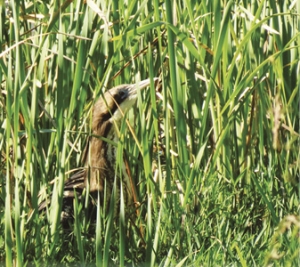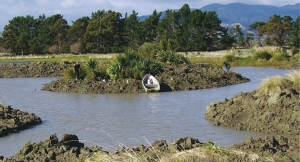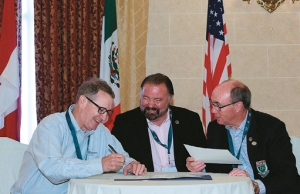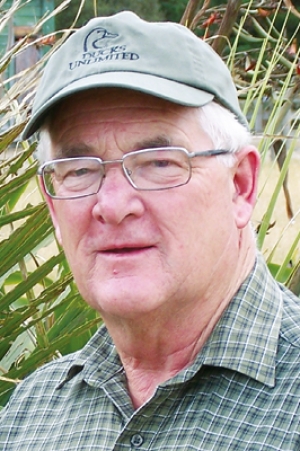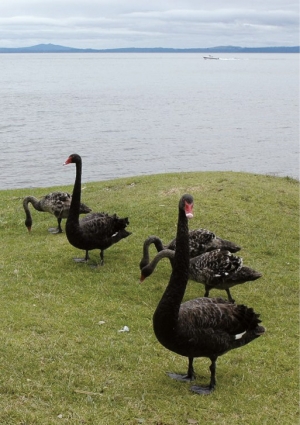Super User
The Bitterns are a Booming
Bitterns are an iconic wetland bird which is becoming increasingly rare through wetland loss and predation by mammalian predators.
They are the apex avian predator in many wetlands and their presence gives an indication of overall wetland condition and health.
I was fortunate that Greater Wellington Regional Council engaged me last year through my small wetland consultancy WetlandWorks to carry out wetland bird surveys on a number of wetlands on the eastern side of Lake Wairarapa. This included Boggy Pond, Mathews Lagoon, Wairio wetland, JK Donald Block and Bartons Lagoon.
Each trip was 8-10 days duration and we based ourselves at Kilmore Lodge, a great home away from home owned by Wellington Fish and Game. One of my recommendations to the Council was the need to carry out a bittern survey of all wetlands around the lake to get a good handle on the population and what threats each site was subject to.
The survey, carried out over two weeks in October and November 2013, focused on locating male bittern who in spring advertise their presence by making a booming call much like a fog horn. They establish territories in mainly dense raupo and use this call to advertise their presence to available females and make other males aware not to come near. The main calling periods are one hour either side of sunrise and sunset. Occasionally they boom all night and all day when there is plenty of action on. This requires regular early starts and late finishes for the bittern counters.
During the survey 20 male bittern were recorded booming and their territories plotted on a map. Seventeen of the booming birds were calling from patches of raupo and the other three from scattered wet patches of oioi (jointed rush), closer to the eastern lake edge.
The main concentrations were around five key sites: Boggy/Mathews/Wairio, Ponui Lagoon, Barrage Gates, south Donald/Mangatete Stream and Bartons/Tauherenikau River mouth.
While bittern are polygamous and males can attract more than one female to their territory, some males are unsuccessful at attracting any. Other studies indicate the sex ratio is about 1:1 so the total population for Wairarapa Moana and associated wetlands is around 40 birds. A report is currently being prepared for Greater Wellington Regional Council that will discuss how these wetlands can be better managed for bittern.
Bittern Workshop
A “meeting of the minds” for people working on bittern was held at Kilmore Lodge, Boggy Pond, Wairarapa on November 2 last year. This was attended by the DOC bittern scientist from Christchurch, other DOC staff, a university student doing a doctorate on bittern, and Greater Wellington Regional Council staff.
This was followed by a get together of local people and landowners interested in bittern around Wairarapa Moana. About 25 people overall.
The presentations and discussions that followed focused on the biology of bittern, habitat use and threats from plant and animal pests and was followed by a short trip to the Boggy Pond car park where everyone heard three of the local male bittern booming and advertising their wares.
A great opportunity for everyone to share information on this threatened but still keystone wetland bird.
John Cheyne
Wetland Care
Our business is to harness community, business and government resources to restore and develop lost wetland areas within New Zealand.
environment, acting as huge ecological sponges by soaking up pollutants and filtering water before it reaches streams, rivers, lakes, aquifers and the sea.
Our initiatives focus on matters as far-reaching as groundwater replenishment, flood control, nutrient and contaminant management and climate change – all critical factors for the conservation of freshwater and saltwater wetlands and marshes.
We want to preserve and conserve the flora and fauna of our most endangered ecosystem so that vibrant wetlands are our legacy to future generations.
Central to Wetland Care New Zealand’s mission is forming partnerships with people and organisations with similar aims. Money from our partnership with Banrock Station Wines has been given to wetland conservation projects done by, among others:
- Tutukaka Landcare Coalition
- Tawharanui Open Sanctuary Society Inc.
- Ducks Unlimited Operation Pateke
- Port Charles release 2005 at Coromandel
- Henley Trust, Masterton
- Karori Wildlife Sanctuary, Wellington
- Kitchener Park, Feilding
- Manawatu Estuary Trust, Foxton
- Mangaone Wetland, Raetihi
- Masterton Intermediate School
- Steyning Trust, Hawke’s Bay
- Travis Wetland Trust, Christchurch
- Wairo Wetland, South Wairarapa
- Wetland Trust New Zealand,
- Rangiriri Waitakere Branch Forest and Bird
- Yellow-eyed Penguin Trust, Dunedin
- Cape kidnappers pateke release, 2008 and 2009
- Fiordland pateke release, 2009.
Ducks Unlimited Canada – 75th Anniversary Celebrations
Top of the Flyways: DUC celebrates 75 years of conservation excellence
In the heart of the prairies at the height of fall migration, Ducks Unlimited Canada (DUC) celebrated 75 years of conservation
excellence with friends and colleagues from across North America.
A special Top of the Flyways convention took place on October 5, 2013, with events held at the historic Fort Garry Hotel in Winnipeg, Manitoba and at DUC’s national office and flagship interpretive centre at Oak Hammock Marsh.
Business session
Speakers from across North America shared thoughts on DUC’s past, present and future during an informative and inspiring business session. Flyway Showcase
Nearly 900 visitors enjoyed a sunny fall day at the beautiful Oak Hammock Marsh Interpretive Centre to learn more about wetland
conservation. Conservationists of all ages got a hands-on look at DUC’s work and its importance in their lives. From radio telemetry demonstrations to bird identification challenges, critter dipping stations and more, the marsh was buzzing with activity. Plus, the sights and sounds of fall migration provided the perfect backdrop.
The historic cabin that once marked the spot of DUC’s first conservation project at Big Grass Marsh was the focal point for a special donor dedication. The cabin now resides at Oak Hammock Marsh, and a new cairn was unveiled to recognise more than 200 donors who contributed to a special major gift campaign in honour of DUC’s 75th anniversary.
Glamorous Galas and Down-Home dinners
Two fantastic sold-out events capped off Top of the Flyways. a signature gala at the Fort Garry Hotel was a vision of style, while the Marsh Keepers Migration dinner under a tent at Oak Hammock Marsh provided attendees with a spectacular setting to view results of DUC’s conservation work.
Saluting leaders, honouring legacies
Throughout its history, DUC has benefited from many pioneering and visionary leaders. Thirty-eight different men have served in the important and influential position of DUC President. Thirteen of DUC’s living past presidents joined delegates at the Top of the Flyways convention, and were honoured during a special ceremony.
75 Years of Conservation Excellence
Ducks Unlimited Canada (DUC) pats its own back – and so they should. It has been 75 years in the making, but they say wetland and waterfowl conservation has only just begun.
DUC celebrated its 75th anniversary in 2013. That’s three-quarters of a century of work conserving critical wetlands including marshes and ponds.
Together, they have conserved 6.4 million acres (approx 2589988ha) and completed nearly 9,400 habitat conservation projects. Building on the strong foundation developed by the founders back in 1938, DUC is continuing their rich tradition of wetland conservation and writing a new chapter for waterfowl, wildlife and all Canadians.
Read more about the DU Canada celebrations here.
Science in the Swamp - WETmak now live
WETmak is a free online Wetland Monitoring and Assessment Kit aimed at groups working on wetland restoration projects in New Zealand. It includes a range of monitoring techniques and methods of assessing the impact of restoration work, all designed to minimise the need for expensive or complicated equipment.
The kit is available in different formats to suit user needs. You can download the entire resource or focus on specific modules. Blank datasheets and report templates can be printed off or downloaded to fill in electronically.
Download WETmak, print out a few datasheets, pull on your gumboots and head out with friends to get measuring. Increasing understanding of your restoration work will bring huge rewards and provide useful information for future planning.
There are 40 Wetlands to visit. DoC in association with the National Wetland Trust has produced a booklet about the 40 wetlands you can visit.
Pick up a copy at your local DOC info centre or visit the DOC website to view them online.
A feature wetland is Nukuhous Saltmash, Burke Road, Ohiwa Harbour, Bay of Plenty.
Nukuhou Saltmarsh covers about 60 hectares where the Nukuhou
stream enters the Ohiwa Harbour. In 2003 the Nukuhou Saltmarsh Care Group was formed and with the help of the DoC and Environment Bay of Plenty, began a significant restoration and interpretation project.
Extensive plantings, weed and pest control, an overlook, interpretation panels, pottery bird plaques, a short boardwalk and a contemplation bench have made this a pleasant place to enjoy the wetland and listen quietly for fernbird calls (a high pitched single note).
Pest control has boosted fernbird numbers, as well as banded rail, Australasian bittern and waders.
From The President
The last few months since my appointment at the AGM in Napier, has gone quickly. Looking back we are making good progress on a number of fronts.
The 1200 metre low bund was constructed at Wairio to capture and hold extra water and it is performing exactly as it was designed. When I was on site there in October it was holding about 25 hectares of water with a maximum depth of 1.2 metres. Local DU members and volunteers had commenced planting along the bunds to provide cover for wildlife and protect the bund from wave lap erosion. Excellent habitat for a wide range of wetland birds including bittern, pied stilts, dabchick and waterfowl. Jim Law, Ross Cottle and team are now looking at replicating this for the block immediately to the south. This “think big” approach is certainly paying off.
I am also the DU nominee on the NZ Game Bird Habitat Trust which distributes about $100,000 each year to worthwhile wetland projects and $2 from each waterfowl hunter’s licence goes into a national fund for this purpose.
The Trust members met in November in Blenheim to inspect the Nelson – Malborough Fish and Game Para Wetland project located alongside SH1 between Picton and Blenheim. This large project has the same challenges as many wetlands: declining water levels and invading willows. There is a long term restoration plan in place currently being funded by the Trust at about $18,000 per year. The sight of large dead crack willows as you drive past looks like a grave yard but they are starting to win the battle. Native fish and wetland birds, including waterfowl are the beneficiaries.
On behalf of the Board, I hope you all had a very merry Xmas and will have a prosperous New Year. The AGM will be in the Wairarapa this year and planning is well underway to make this a success. Look forward to seeing you there.
John Cheyne
Hands off our kiwi
Those Aussies are trying to steal our things again!
There have been claims that the Kiwi actually originated in Australia.
Black swans, introduced or native?
however, in flight the bird shows wide white wing margins. It has a bugle-like call, and hisses to defend its nest.
About 100 black swans were brought to the South Island from Australia in the 1860s, and the species has traditionally been regarded as introduced. However, numbers have increased faster than expected, suggesting more birds arrived independently – in which case it should be considered a self-introduced native.
To add to the intrigue, the extinct native swan, mentioned in paragraph one, previously named Cygnus sumnerensis, is now thought to have been the same species as the black swan.
Black swans breed either in pairs or in colonies. Their nests are huge mounds of long foliage, built near lake edges. Females may lay up to 14 green eggs, but six is the average. In colonies, up to 40 cygnets gather in large crèches guarded by a few adults.
Juveniles leave their natal lake and spend several years in estuarine or coastal sites, returning to take up permanent residence once they reach breeding age at between two and four years old. Not all birds breed every year. The oldest known swan in New Zealand was at least 29. Black swans are partially protected, and are hunted in season according to regional limits. About 5000 are shot each year.
Thanks to Te Ara Encyclopedia and Wikipedia.
Trapline volunteers
The old traps came out of the boxes and new stainless steel ones went in. Replacing a line like this can take a couple of weeks so the volunteers really made a difference. With each person carrying six traps in and another six out as well as some tough climbs along the way, it was a big day.
This trap line protects the whio living along streams and rivers such as the Maketawa and they form a network that covers around 7000 hectares. Last year was a record year for whio ducklings in the Park with 33 ducklings hatching in the wild.
Recently though he’s found another.”
Whitefaced herons are New Zealand’s most common heron. They arrived from Australia in the 1940s so they’re considered native. This one’s been around long enough to be called a local.
Wetlands to protect
Wetland importance is often under-rated. Groups like our own DU, Wetland Care and the National Wetlands Trust are working towards reversing this trend.
There is a great diversity of wildlife in our wetlands with more native birds, fish,
invertebrates and plants than most other habitats, yet many wetland species are threatened with extinction. Wetlands have high recreational values, and perform vital ecosystem services such as improving water quality and reducing flood risks.
They have a big role in managing climate change. Healthy peat bogs are year-round sinks of 2-5 tonnes of carbon per hectare – locking it up in their soil indefinitely.
Wetlands are of cultural and spiritual significance to Maori. They provided Maori with food (wildfowl, eels and other freshwater fish), taro cultivation, harakeke (flax) for weaving and other materials for medicinal, food, building, and craft use.
A plethora of wetland to visit
Managed by DOC, the 5923ha of peat bog, swampland, mesotrophic lags, open water and river systems, is an important habitat for threatened species like Australasian bittern, grey teal, spotless crake, the North Island fernbird and black mudfish.
Firth of Thames
At the base of Coromandel Peninsula, the Firth of Thames has 8500ha of wide inter-tidal flats which attract thousands of migratory wading birds. Some make the arduous 10,000km journey south from the Arctic in spring and fly north again in the autumn; others fly 1000km north from the braided rivers of the South Island in the autumn and return in the spring.
Wairarapa Moana Wetlands Park
Lake Wairarapa, Lake Onoke and their associated wetlands make up the largest
wetland complex in the southern North Island, supporting native plants and animals of national and international importance.
The diverse habitats within Wairarapa Moana attract a wide range of wetland birds - about 100 species including international migratory birds.
Lower Kaituna Wildlife Reserve
Northeast of Te Puke, western Bay of Plenty, Kaituna is a reminder of how the country used to be with an abundance of cabbage trees and flax, pukeko prowling through raupo, numerous ducks, shags and pied stilts foraging for food in the waterways.
West Coast wetlands
The South Island’s West Coast has a variety of large and valuable wetlands, including lakes, swamps, fens, bogs, marshes, lagoons,
Ō Tū Wharekai wetland
Ō Tū Wharekai, covering the Ashburton lakes and Upper Rangitata River in Canterbury, is an unspoiled, intact, intermontane wetland system and is nationally important for wildlife.
Otago wetlands
Lake Waipori, Lake Waihola and their associated wetlands are the most significant waterfowl habitat in Otago 40km south of Dunedin. The lakes are shallow and drain through an extensive swamp into the Waipori River and then the Taieri River.
Over 60 species of bird live in or visit the wetland. It is now privately owned by Te Rūnanga o Ngāi Tahu and protected by a QE II National Trust Open Space Covenant.
More than 80 bird species have been sighted in the area, 65 of which are dependent on the estuarine environment.
Southland’s estuaries rank alongside Farewell Spit and Lake Ellesmere as the top three wading bird habitats in the South Island.

